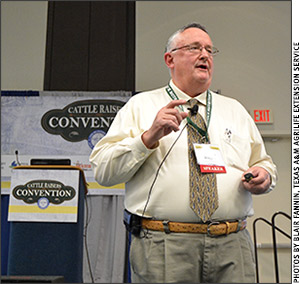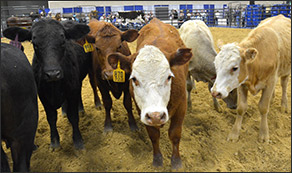Capturing Pounds and Profits
Beef cattle producers should seek every pound of gain possible.
In a high or low cattle market environment, capturing the most pounds per calf affects a producer’s bottom line, said a Texas A&M AgriLife Extension Service economist.
Mac Young, AgriLife Extension economist in Corpus Christi, told attendees at the recent Texas and Southwestern Cattle Raisers Association (TSCRA) convention in Fort Worth that beef producers have obviously enjoyed the record-high prices they’ve received the past couple of years.
However, purchasing replacement females has been an expensive proposition, he said.

Mac Young, Texas A&M AgriLife Extension Service economist, Corpus Christi, told cattle producers at the recent TSCRA convention that they should produce as many pounds of beef as possible to improve their bottom line whether it’s a high-price or low-price market environment.
“Prices for 2016 are obviously higher than 2012. That’s great if you are selling, but not so great if you are buying replacement heifers or cows,” he said. “We’ve seen those record-high prices come down a bit since late last year and you need to do everything you can to put as many pounds on your calves as possible.”
Young said the Texas beef cow inventory was at 4.3 million head at the beginning of 2016, with approximately 134,000 farms averaging 32 cows per farm. The beef cattle inventory continues to rebound after the devastating drought of 2011-2013.
Citing a 2014 AgriLife Extension study led by the Farm Assistance program, Young emphasized that an all-calf management program can help produce extra dollars in an operation.
“With all-calf management, you are attempting to produce as many pounds as possible,” he said. “What is important whether you have low or high prices, you need to maximize the number of calves you get out of your herd and improve the quality to increase the prices you receive. Even when you have high prices or whether you have a low-price scenario, it does affect your bottom line.”
The Farm Assistance study focused on a 2,000-acre ranch consisting of 1,800 acres of native pasture and 200 acres of established Coastal Bermuda grass used for grazing only. Under normal stocking rates, the cow herd included 200 cows or a stocking rate of one animal unit to 10 acres and eight bulls, or one bull to 25 cows. (Click to listen to audio report: http://today.agrilife.org/wp-content/uploads/2016/04/AllCalfManagement.mp3)
The study took into consideration production inputs, yields, costs and overhead charges based on typical rates for the region. In 2014, hunting income for the ranch was $10 per acre. Assets, debts, machinery inventory and scheduled equipment replacements for the projection period were the same in all management scenarios.

A group of calves at the 2016 TSCRA Convention.
With no selected calf management practices, average net cash farm income was $76,970 a year or $385 per cow per year and $428 per calf per year. An all calf-management program of clostridial vaccinations, castration/implants and deworming led to net cash farm income of $89,360, representing $477 per cow per year and $496 per calf per year.
“This reflects a 16.1% increase or $12,390 increase versus no calf management practices,” Young said. “All of these practices help produce more dollars when selling calves. The worst thing you can do is have a cow out there that isn’t having a calf. That’s cutting into your profits.
“The point I’m trying to make is you are going to have good market prices, and you are going to have bad market prices. That’s why as a producer you need to produce as many pounds as possible. To me, it’s a hedge. You are trying to increase your volume of calves, which in the end will help your bottom line,” said Young.

Editor’s Note: Blair Fannin is a media relationship specialist with Texas AgriLife Communications.






